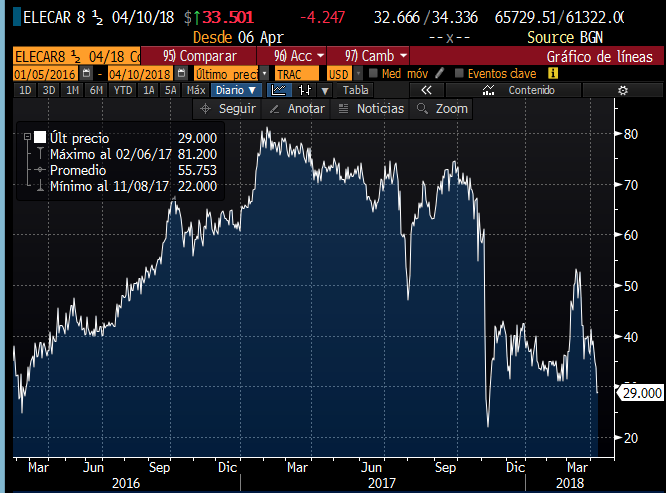Maduro Defaults on Some Bonds, Pays Others and Nobody Bats an Eye
The Maduro administration defaulted on the USD 650M payment of Electricidad de Caracas’ 2018 bonds due on April 10, as expected by the market. However, PDVSA 6% 22 bond coupons due since October were released to investors. State media and officials remain in full blackout mode.


Photo: El Impulso
April 10, 2018 marked a new chapter in the still-ongoing Venezuelan debt default saga, as the Electricidad de Caracas (ELECAR) 2018 bond payment was completely ignored by a government that has kept its head buried in the ground when it comes to the growing pile of economic issues we face.
ELECAR 2018 presents several idiosyncratic characteristics that are key in understanding the Venezuelan debt default saga; it represents, more than any other VENZ/PDVSA bond, the “distressed debt” character, persistently trading at a lower price (and thus, at an attractive higher yield) than the rest of the curve.
The “relative value” in ELECAR ’18 enticed capital inflow, mostly from retail investors, throughout 2017. The bond was seen as “the trade of the year” by Venny Bulls, with hopes that Maduro & Co. would maintain its willingness to pay at all costs for another year.
Unfortunately for the bulls, reality knocked them out mere months later. Maduro’s infamous debt restructuring/renegotiation announcement of last November 2 cut its value in half. The market unequivocally signed that default was a done deal, and the “trade of the year” turned out to be a total dud.
ELECAR ’18 bonds were initially announced in Nov 10 by the Wilmington Trust Company, the bonds’ trustee. The government hadn’t made any of the accustomed social media postings announcing that funds for the coupon payments were transferred to the fiscal agent; it quickly replied to the trustee’s notice by stating that funds were transferred that day and the delay was triggered by “operational changes that affected transactionality.” A technical way of simply saying: “It wasn’t me”.
According to multiple market sources, the USD 27.5M coupon on ELECAR was partially received by investor accounts. It appears that custodian Euroclear has credited the amounts to final clients, while Clearstream has withheld the funds and launched a compliance investigation into the irregular payments chain.
Sources claim that the government skipped the fiscal agent mandated by the bond indenture, instead wiring payments directly to the custodians in irregular batches. There has been notorious hermetism by both custodians and government officials, beyond a leaked Clearstream update confirming the compliance inquiry, also stating it relates to Executive Order #13808 of the US Treasury Department (Aug 25, 2017, prohibiting issuance of new debt by Venezuelan entities).
A thorough scan of Twitter and other sources suggests the government has not only missed mentions of the ELECAR due date, but in general has left aside the debt default issues.
Adding confusion, news broke during the day that a USD 90M coupon payment on PDVSA 6% 22 bonds, due since Oct 28, 2017 was also withheld and, under investigation, was released to investors. The PDVSA 6% 22, also known as “hunger bonds”, are held mostly by Goldman Sachs Asset Management, and the released coupon amounts to the last debt payment serviced by the Maduro government on any of its bonds. Besides no official confirmation, a lingering question (why is PDVSA being released and ELECAR isn’t?) remains unanswered.
The official reaction has been silence.
A thorough scan of Twitter and other sources suggests the government has not only missed mentions of the ELECAR due date, but in general has left aside the debt default issues, focusing all its propaganda machine to prop up its heterodox economic policy mix:
- DICOM FX alternate system: Last trade at VEF 60,795 per dollar. Private sector sources claim retail and corporate transactions are going smoothly, but weekly volumes are insignificant, totalling less than 2 million EUR per auction on average.
- “Bolivar Soberano” currency redenomination: A non-event in practice until at least June.
- Petro: The ICO ended on March 31, but the government hasn’t released results of the offering (Maduro promised on April 6 a full balance “in the coming days”). Several government officials have appeared in the press announcing the use of Petros for multiple government-related transactions, but it appears to be a purely political gesture.
Even though a debt default completely ignored by the issuer is probably the most troubling sign a bondholder could ever face, the fact that the market barely shrugged the April 10 non-event suggests investors are probably fixated in another, even more pressing payment due: PDVSA 2020s coupon, due on April 28. The circle of vultures surrounding Citgo might not be as forgiving to this payment being missed without explanation.
El 28, el 28… se viene.
Caracas Chronicles is 100% reader-supported.
We’ve been able to hang on for 22 years in one of the craziest media landscapes in the world. We’ve seen different media outlets in Venezuela (and abroad) closing shop, something we’re looking to avoid at all costs. Your collaboration goes a long way in helping us weather the storm.
Donate





